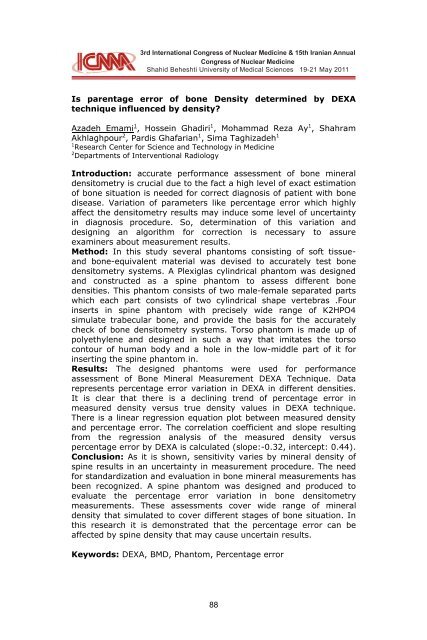Panel Disdussion
Panel Disdussion
Panel Disdussion
You also want an ePaper? Increase the reach of your titles
YUMPU automatically turns print PDFs into web optimized ePapers that Google loves.
3rd International Congress 3rd International of Nuclear Congress Medicine of Nuclear & 15th Medicine Iranian Annual & 15th Iranian Congress Annual of<br />
Nuclear Congress Medicine of Nuclear Medicine<br />
Shahid Beheshti Shahid Beheshti University University of Medical Sciences of Medical 19-21 Sciences May 201119-21 May 2011<br />
Is parentage error of bone Density determined by DEXA<br />
technique influenced by density?<br />
Azadeh Emami 1 , Hossein Ghadiri 1 , Mohammad Reza Ay 1 , Shahram<br />
Akhlaghpour 2 , Pardis Ghafarian 1 , Sima Taghizadeh 1<br />
1 Research Center for Science and Technology in Medicine<br />
2 Departments of Interventional Radiology<br />
Introduction: accurate performance assessment of bone mineral<br />
densitometry is crucial due to the fact a high level of exact estimation<br />
of bone situation is needed for correct diagnosis of patient with bone<br />
disease. Variation of parameters like percentage error which highly<br />
affect the densitometry results may induce some level of uncertainty<br />
in diagnosis procedure. So, determination of this variation and<br />
designing an algorithm for correction is necessary to assure<br />
examiners about measurement results.<br />
Method: In this study several phantoms consisting of soft tissueand<br />
bone-equivalent material was devised to accurately test bone<br />
densitometry systems. A Plexiglas cylindrical phantom was designed<br />
and constructed as a spine phantom to assess different bone<br />
densities. This phantom consists of two male-female separated parts<br />
which each part consists of two cylindrical shape vertebras .Four<br />
inserts in spine phantom with precisely wide range of K2HPO4<br />
simulate trabecular bone, and provide the basis for the accurately<br />
check of bone densitometry systems. Torso phantom is made up of<br />
polyethylene and designed in such a way that imitates the torso<br />
contour of human body and a hole in the low-middle part of it for<br />
inserting the spine phantom in.<br />
Results: The designed phantoms were used for performance<br />
assessment of Bone Mineral Measurement DEXA Technique. Data<br />
represents percentage error variation in DEXA in different densities.<br />
It is clear that there is a declining trend of percentage error in<br />
measured density versus true density values in DEXA technique.<br />
There is a linear regression equation plot between measured density<br />
and percentage error. The correlation coefficient and slope resulting<br />
from the regression analysis of the measured density versus<br />
percentage error by DEXA is calculated (slope:-0.32, intercept: 0.44).<br />
Conclusion: As it is shown, sensitivity varies by mineral density of<br />
spine results in an uncertainty in measurement procedure. The need<br />
for standardization and evaluation in bone mineral measurements has<br />
been recognized. A spine phantom was designed and produced to<br />
evaluate the percentage error variation in bone densitometry<br />
measurements. These assessments cover wide range of mineral<br />
density that simulated to cover different stages of bone situation. In<br />
this research it is demonstrated that the percentage error can be<br />
affected by spine density that may cause uncertain results.<br />
Keywords: DEXA, BMD, Phantom, Percentage error<br />
88
















